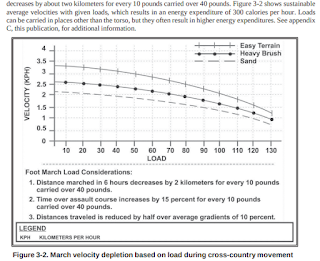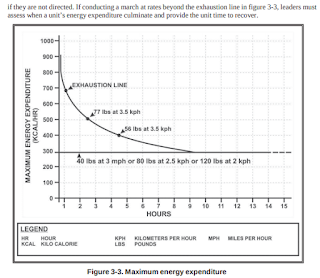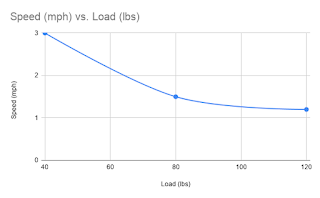I wanted to take some real-world numbers and use them as a basis for a simple overland travel system for RPGs. I’m not the first person to do this, nor will I be the last, but here’s my take on it.
Let’s find the caloric density of various trail foods. Looking in my pantry, nuts are around 160 kcal/oz; grains, lentils, and beans are around 100 kcal/oz; and cheese is around 100 kcal/oz. So let’s call it 120 kcal/oz for ease of calculation (or, 1,920 kcal/lb). Let’s round that up to 2,000 kcal/lb.
A quick Google gives a figure of 4,400 kcal/day of food requirements for a loaded 160lb person hiking 8 hours per day. So using the above caloric density, food supplies will weigh about 2 lb per day. This actually lines up nicely with the example meal plan on that same page, which has 4,580 kcal of food weighing 2 lbs.
A good rule of thumb for water is 1 gallon per person per day. 1 gallon weighs about 8 lbs, so add another 8 lbs per day for water (obviously this may be reduced if traveling near a source of fresh water).
Another quick Google gives us a max pack weight equal to 20% of body weight. Using our example 160 lb person from above, our pack should weigh 32 lb. However, that’s for civilians on a relatively lightweight backpacking trip. The military has spent a lot of time any money researching just how much stuff they can pile on their soldiers, so let’s see what they say. Army Field Manual ATP 3-21.18 Table 3-4 gives a “fighting load” of 30% body weight, and an “approach load” of 45% body weight. This would be 48 lbs to 72 lbs, respectively for our 160 lb person.
To go into a little more detail, let’s look at a few very interesting charts. That field manual specifies a “sustainable” energy expenditure of 300 kcal/hr, which results in the load vs speed curve shown below in Figure 3-2 for various terrains. If I’m reading Figure 3-3 correctly, that energy expenditure of 300 kcal/hr can be sustained indefinitely (apart from time to sleep, of course), and as you increase the energy expenditure you can march for a shorter and shorter time period before becoming exhausted (for example, energy expenditure of 500 kcal/hr, which is equivalent to carrying 77 lbs at a pace of 3.5 kph, will exhaust a soldier in 2.5 hours).

Figure 3-2

Figure 3-3
Going back to that “approach load” of 72 lbs from before, we see that puts us at a sustainable speed of around 1.5 mph, but we’ll be exhausted in a mere 2.5 hours when moving quickly at 2.2 mph / 3.5 kph. This seems to mean that an “approach load’ is just that; intended to make a rapid approach to an enemy position over a relatively short distance (~5 mi). It is NOT a sustainable load for long daily marches, unless you want to move very slowly.
There’s probably enough meat here for a very realistic forced march system, but I’ll leave that for another time. For now, for our purposes of overland travel in an RPG game, let’s stick to that “sustainable” energy expenditure of 300 kcal/hr. Figure 3-3 says that the following loads give 300 kcal/hr:
| Load (lbs) | Speed (mph) | Speed (kph) |
|---|---|---|
| 40 | 3.0 | 4.8 |
| 80 | 1.5 | 2.5 |
| 120 | 1.2 | 2.0 |

So, it looks like doubling our load roughly halves our speed, and tripling our load slows our speed to a third. And, the carrying capacity of one average man that is sustainable indefinitely at full speed is about 40 lb. This figure jives with both the civilian backpacker math, and the low end of the military load calculation.
One thing to note is that most of that 40 lb carrying capacity is taken up by armor, weapons, mess kits, shelter, etc. A simple mail hauberk might weigh 20 lbs, a sword weighs ~3 lb, and a shield weighs ~10 lbs. That’s most of your personal carrying capacity budget right there, leaving precious little for food. For this reason, when dealing with parties of more than a few people who are heavily geared-up, I think mandating supply mules to carry food and water both makes the travel more realistic, and makes tracking food supplies much easier. Let’s assume the entirety of our adventurer’s combat load is taken up by arms, armor, and gear, and all food must be carried on mules.
How much can mules carry? Again, the US Army has us covered with FM 3-05.213. It recommends a pack weight of “35 percent of their body maximum (150 to 300 pounds)” in paragraph 1-2. Let’s round this to 200 lb. Using the food and water weights from Part I, one mule can carry 100 person-days of food, or 20 person-days of food and water.
So, to move at a fast pace of 3 miles per hour, a party of four adventurers with one pack mule can go on a 5-day journey. But what if they don’t have mules? Going back to the “approach load” and Figure 3-3 from Part II, it looks like 80 lbs is about the max that a man can carry and still function properly. A man burdened with 80 lbs can march at 1.5 mph (half speed) indefinitely, and can perform short “sprints” of 3 mph for a few hours at a time. These extra 40 lbs over their combat load can be used to carry 20 days of food, or 4 days of food and water.
Brendan over at Necropraxis has a great post about using hex maps as pseudo-pointcrawls. Building off of that, I think two things are involved in travel - distance and time. What if we use Brendan’s one-day-per-hex idea, but keep distance accurately represented on the map, and use supplies to represent time instead? A pace of 3 mph over a 6-hour marching day gives a distance traveled per day of 18 miles. This lines up roughly with expected thru-hiking paces and historical military paces (in the 15 mi/day to 25 mi/day range).
So let’s set this as our hex size - 18 miles. To move one man into the adjacent hex, it would take one day and consume one day’s worth of supplies. If the man was moving at half speed from being encumbered with an approach load, it would take him two days and consume two days of supplies (while being able to carry fewer supplies, assuming he has no mules with him!). This makes travel without a supply train extremely punishing, and requires the creation of logistics trains to support large or long expeditions. It also allows difficult terrain slowing travel to be represented by a penalty of additional supply consumption.
To summarize, here are the provision needs of various configurations of parties when moving through an 18-mile hex map.
| Configuration | Man-Days of Supplies Consumed per Man per Hex | Man-Days of Supplies, Food Only | Man-Days of Supplies, Food & Water |
|---|---|---|---|
| Combat load (40 lbs) | 1 | 0 | 0 |
| Approach load (80 lbs) | 2 | 20 / man | 4 / man |
| Mules | 1 | 100 / mule | 20 / mule |
Difficult Terrain: Consume 1 additional man-day of supplies per hex.
 A Great Lakes Hexmap
A Great Lakes Hexmap